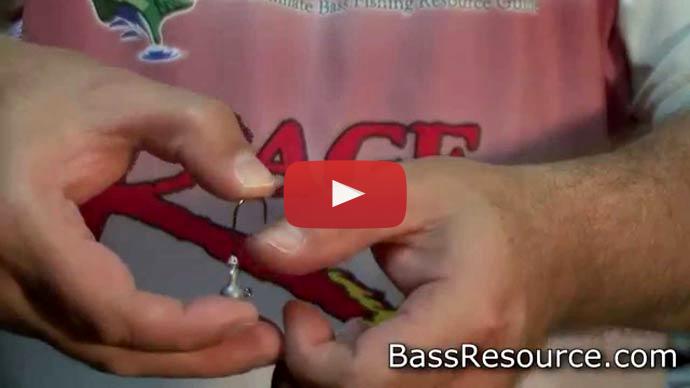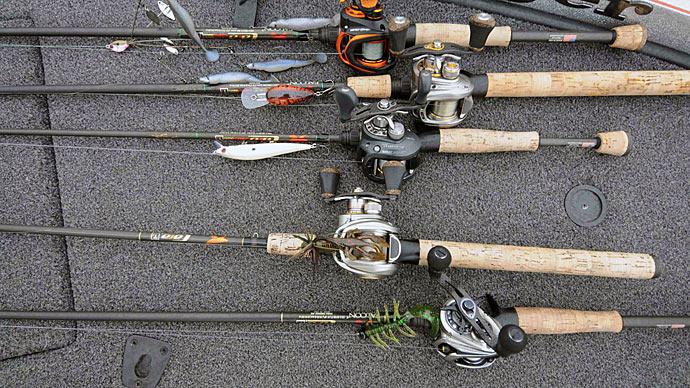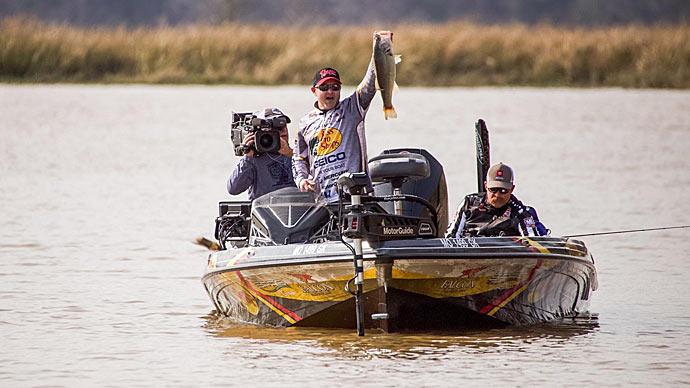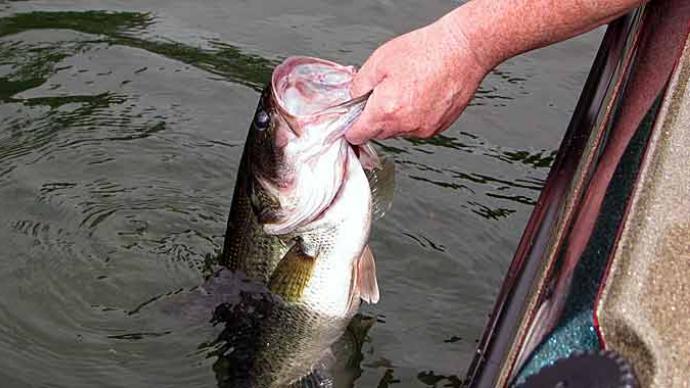Hey folks. Glenn May here at BassResource.com and today I want to talk to you about how to set up your rod, your reel, and your line, and your hooks so they're matched. It's a matched set. This is really important when it comes to bass fishing because if you’ve got one weak link in there, that's usually the thing that's going to fail on you when you're reeling in that lunker and then you're going to be left scratching your head wondering what happened. So it's important to have a balanced system. So what I do, everything starts off with the hook. What size hook am I using? What kind of hook am I using? From there, it derives from that.
So for example, finesse fishing. With finesse fishing, you're using a real thin hook. Here I've got a little spider wire, spider jig, you can see it's just a little hook, hooked very well here, but it's a small, yeah, it's about a 1/0 hook. It's a thin wire hook on a little football jig, but it's a real thin wire hook. Now, if I were to put this on a 65-pound braid with a stout rod, if I set the hook on a fish, that hook is just going to straighten out and that's exactly what you're trying to avoid. Because what happens is your line is strong, your rod is strong, you've got your reel cranked down, all that's strong, but you've got a thin wire hook. Well, that's the part that's going to give, you know, it'll straighten out. So you want to match it.
So in this case, what I'm doing is I'm using six pound fluorocarbon line, fluorocarbon has got a bit of a stretch to it, a little bit of give but it's super sensitive. So when I set that hook, it's not going to put all that pressure on that hook. I'm using a nice light spinning rod. It's a medium light power rod. Lots of flex in it, so it has lots of give when the fish is...not only when I set the hook, but when the fish is fighting you back to the boat, it has a lot of give when a fish does that run. And then I'm using a spinning gear. In this case, this is spin is...I've got the drag set nice and light on it, so when that fish makes that run, it just peels right off nice and easy.
Spinning reels, by the way, have, in my opinion, some of the best drags out there. Real nice and smooth, which is what you need when you're using light line and light hooks. You have that give and that drag is super, super important. So that's what I'm using when I'm fishing spinning outfits or...excuse me when I'm fishing finesse rigs.
Now going a little bit higher up, if I'm fishing say, for example, a Texas Rig, Standard Texas rig. Here I'm fishing, this is the Jack-of-all-trades or the rod is a medium heavy power fast action tip rod. This, you can use it for a variety of situations. You can use it for Texas rigging, you can use it for spinnerbaits, you can even use it for crank baits, top water. I mean, this is the Jack-of-all-trades. You need to have a couple of these rods for bass fishing. But it all depends on the kind of hook you're using.
So in this instance, I'm using a pretty stout hook because I've been doing some flipping and pitching with it. So you're using a thick hook on it, on this Berkeley Creature Hawg that I've been throwing and you can see it's a pretty stout hook, it's a pretty thick wire hook.
So if I had a thick wire hook like that, a big one like that on the setup I just showed you and I set up, that rod's going to give, that line's going to stretch, that drag is going to pull and you're not going to get much muscle on that fish because the hook just won't penetrate. I mean, you've lost all that energy on that lighter... You need a lot of power to get a thick wire hook set in that fish. Thin wire hooks don't take so much energy, so you can use that setup, but this is real thick, so I need more power to set the hook. And so because it's a thick wire hook, it's going to put up with the pressure of the hook set and the fight back to the boat.
So in this instance, I'm using Fireline Ultra 8 and it's that eight-strand braided line, 30 pound test. It doesn't have any give at all. No stretch. This rod's got a little bit of stretch on the end of it, on the tip, which is what a typical medium heavy rod is. It's got that kind of flex to it. So that's what you need.
And then the drag on this thing, I'm using a REVO SX reel. I love it and I love this Abu Garcia REVO reel. I love these Abu Garcias. It's got 24 pounds of drag on it, so I can crank this baby down, really strong and haul that fish out. So that's what you need when you're fishing some of this heavier cover, you can crank that drag down and because I got this heavy rod, I've got a strong hook, it's going to put up with all that pressure.
Now, if I were fishing say a spinner bait, very similar setup because spinnerbaits have 4- and 5/0 real thick hooks and I'd use, again, very similar setups. I'd, again, use a seven foot, medium heavy rod, in that instance, I might go to a copolymer line because I'm not throwing so much in brush or cover like I would with a Texas rig like this, so I don't need all that abrasion resistance, so maybe a copolymer line. I'd be using 15 pound test for that because, again, not throwing to heavy cover. So it depends on the bait that you're throwing, but again, it's a heavier hook so you can use a heavier set up.
Now let's move on a little bit different. Let's go for some heavy flipping and pitching. This is the stout setup that I like to use when I'm throwing in heavy cover. When the bushes are flooded, I'm throwing in heavy bushes, trees, I'm throwing in thick weeds, thick milfoil and then digging the fish out of it, and I got to fight them, I got to work really hard to get them out. So here I'm using a 7’ 6” heavy power fast action rod. And so with that, again, I've got a nice stout flipping hook on it. This is a 3/0 flipping hook. Here I'm using a 65-pound Seaguar braided line.
This is the Seaguar Smackdown braid. I really like it. It's very abrasion-resistant, works great around all those kind of organic-type cover, which is logs, trees, bushes, even docks, thick weeds, perfect for that kind of setup. This hook's going to put up with that. It's not going to bend. You've got a good system, a reel with real good drag system on it, this happens to be the Helios, the Okuma, Helios reel. I like the drag system on that. If you notice, all my reels are really good, that Abu Garcia reel has a real nice smooth drag on it.
That's critical for these types of things because the ride...the braid doesn't have any give to it, so your drag is going to have to make up for that a little bit, so you got to have a real smooth drag for that. But that's the system that I use for flipping and pitching. It works for me really, really well. I haven't had any problems with it.
Where I would change that is if I was throwing on rocks, throwing a lot of rocks, then a braid doesn't hold up as well under that, it doesn't matter what brand it is, braid just doesn't...isn't designed to hold up on the rocks too well or if you're throwing where there are Zebra mussels, that sort of thing.
So in that instance, I'll switch over to fluorocarbon, maybe a 30-pound fluorocarbon line, something that's stiff, and that's a little more abrasion resistance to that type of cover, but the same setup. I'd still be using the same exact setup. So again, it goes all off of that hook. A thin wire hook, you're using thinner line, you're using lighter rods, lighter reels, and then you go up to the heavy-duty stuff where you've got your drag cranked all the way down. You got your stout rod, you've got a flippin hook. It all derives off that, that size of hook, how stout that is, that has everything to do with my choice of what kind of line that I'm going to use and what rod and reel I'll be setting up with that.
I hope those tips help. I'm telling you what, one thing I got to tell you, not everything is an absolute in fishing. Everybody, you start off as a basis and that's why I'm telling you all this. It's just your beginning point. If you haven't fished these before, this gives you an idea of where to start. But over time everybody develops their own system that they're most comfortable with. Be it a difference pound test line, but a different kind of line, everybody develops a system where they feel real confident in that. And so you're going to get a lot of opinions, a lot of different ideas.
So if what I just showed you isn't exactly what you do, it doesn't mean that you're wrong and it doesn't mean I'm right, or vice versa, it's just I fish a little bit different. This is just to give you an idea of where to start from and then you develop your own system from there. So I hope that helps. For more tips and tricks like this, visit BassResource.com.




